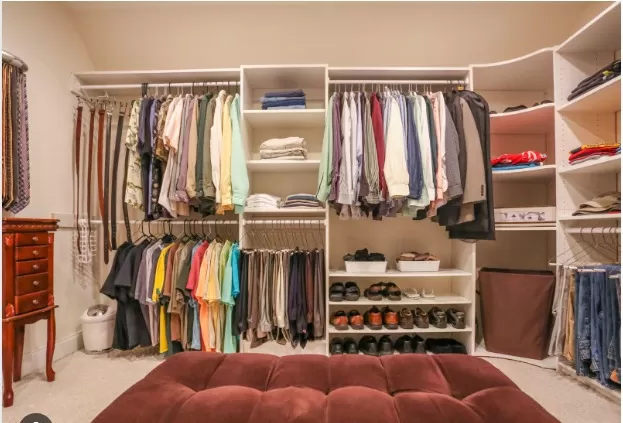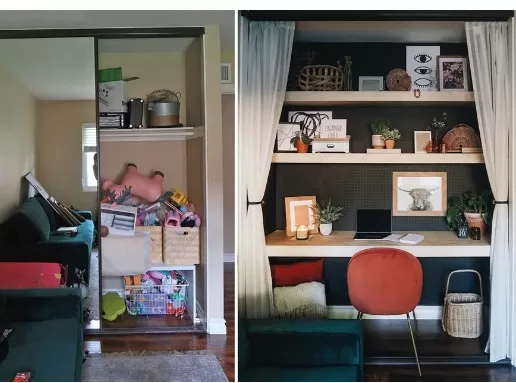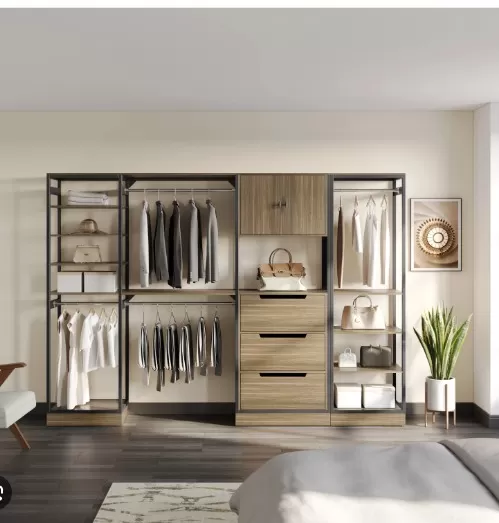Alternative Utilizations for Closet Space. Whether it’s a narrow linen cupboard or a spacious walk-in, a well-designed closet is a highly sought-after feature in any home. However, if storage isn’t a concern, these versatile spaces can be transformed into various small yet functional areas for work and play.
These nooks provide opportunities to create something unique that may not fit elsewhere in the house, such as a wine bar, playroom, or compact office. Closet doors can maintain the element of surprise, or they can be removed entirely to integrate the alcove seamlessly into the larger room. Explore our online gallery for inspiring ideas that will ignite your creativity and guide your own closet transformation project.
Keep Your Bedroom Closet Clutter-Free

A cluttered closet can make it difficult to find what you need and maximize your storage space.
Here’s how to keep your bedroom closet organized and free from items that don’t belong:.
Evaluate storage needs: Determine the specific purpose of your bedroom closet and prioritize items that directly relate to clothing, shoes, and accessories.
This will help you identify what should stay and what can be relocated to other storage areas in your home.
Garage, attic, or basement storage: Items like golf clubs, seasonal decorations, and bulky household tools are better suited for storage in the garage, attic, basement, or dedicated storage areas.
Assess these items and find appropriate storage solutions outside of your bedroom closet to free up space.
Use alternative storage options: Consider utilizing storage solutions that are specifically designed for items like golf clubs, ironing boards, or holiday decorations.
This can include wall-mounted racks, hanging storage systems, or dedicated storage cabinets in appropriate areas of your home.
Hidden valuables or documents: If you need to keep a small quantity of important papers or boxed valuables hidden from view, you can allocate a small space in your bedroom closet for this purpose.
Use secure containers or safes to protect these items while still keeping them easily accessible if needed.
Regular decluttering: Schedule regular decluttering sessions to assess and remove any items that have found their way into your bedroom closet but don’t belong there.
Donate or discard items that you no longer need or use to maintain an organized space.
Utilize closet organizers: Invest in closet organizers, such as hanging shelves, shoe racks, or drawer dividers, to make the most of your available space and keep items neatly organized.
This will help ensure that your clothing, shoes, and accessories have designated areas within the closet.
By dedicating your bedroom closet primarily to clothing, shoes, and accessories and finding alternative storage solutions for items that don’t belong, you can create a clutter-free and functional space.
This will make it easier to find what you need and streamline your Daily Routine.
Creating a Functional Office Space in a Closet

Designating a closet as your home office can be a clever way to maximize space while keeping your living area separate from your work area.
Here are some steps to create an out-of-sight office:.
Choose the right closet: Select a closet that is spacious enough to accommodate a desk and the necessary office equipment.
Consider the dimensions and accessibility of the closet to ensure it can comfortably fit your working needs.
Remove the door: Take off the closet door from its hinges to open up the space and create an open concept office.
This will also help alleviate any feelings of claustrophobia.
Declutter and organize: Clear out the closet and remove any unnecessary items to create a clean and organized space.
Sort through your office supplies and get rid of any items you no longer need or use.
Install proper lighting: Since closets typically have limited natural light, install adequate lighting options to ensure a well-lit workspace.
You can use overhead lighting, desk lamps, or even LED strip lights to brighten up the area.
Choose a suitable desk: Select a desk that fits comfortably within the closet space.
Consider a compact desk or a wall-mounted desk that can be folded away when not in use. Ensure the desk provides enough surface area for your computer, paperwork, and other essential items.
Utilize vertical space: Make the most of the closet’s vertical space by installing shelves or using wall-mounted organizers.
This will help maximize storage for office supplies, books, and files.
Incorporate ergonomic elements: Prioritize your comfort and productivity by incorporating ergonomic elements into your closet office.
Invest in an ergonomic chair, position your computer monitor at eye level, and use a keyboard and mouse that promote good posture.
Manage cables and cords: Keep your workspace neat and organized by managing cables and cords.
Use cable management solutions or adhesive clips to secure and hide cords along the walls or desk.
Personalize the space: Add personal touches to make the office space feel inviting and inspiring.
Hang artwork, use decorative storage containers, or incorporate plants to create a pleasant and personalized atmosphere.
Maintain work-life balance: Since your office is within your living space, it’s important to establish boundaries and maintain work-life balance.
Set specific working hours, close the closet door when you’re done working, and create a clear separation between work and relaxation areas.
By following these steps, you can transform a closet into a functional and efficient office space.
Enjoy the benefits of a dedicated workspace while keeping it out of sight when not in use.
Creating a Cozy Reading Nook in Your Closet
Transforming a spare closet into a reading nook can be a delightful and functional use of space.
Here’s how you can create a cozy reading oasis:.
Empty the closet: Remove all items from the closet, including clothing and other stored items, to create a blank canvas for your reading nook.
Assess the space: Consider the size and dimensions of the closet to determine how you can maximize the available area.
Take measurements and make note of any existing features like shelves or hanging rods that you may want to incorporate into your design.
Build a bench or seating area: Create a comfortable seating area by building a bench along one or more walls of the closet.
This can be done using a combination of plywood, foam padding, and fabric for the cushioned seat. Ensure that the bench is sturdy and securely attached to the wall.
Install bookshelves or floating shelves: Utilize the walls of the closet to add bookshelves or floating shelves for storing books, magazines, and other reading materials.
Consider the height and width of the shelves to accommodate various sizes of books.
Add lighting: Install proper lighting to create an inviting reading environment.
You can use overhead lighting, wall sconces, or even string lights to add a cozy ambiance. Make sure the lighting is adjustable for different reading preferences.
Incorporate storage solutions: Use the space underneath the bench or on the walls to incorporate additional storage options.
This can include baskets, bins, or built-in cubbies to store blankets, pillows, or toys.
Make it cozy: Enhance the comfort and coziness of the reading nook by adding cushions, Throw Pillows, and blankets.
Choose soft fabrics and colors that create a calming and inviting atmosphere.
Personalize the space: Add personal touches such as artwork, inspirational quotes, or wall decals to make the reading nook unique and tailored to your taste.
Provide seating options: If space allows, consider adding a small chair or bean bag to provide additional seating choices for friends or family members who may want to join you in the reading nook.
Create a quiet atmosphere: Make sure the reading nook is free from distractions and noise.
Consider adding curtains or a curtain rod to close off the space when needed.
By following these steps, you can transform a spare closet into a Cozy Reading Nook that provides a peaceful retreat for reading and relaxation.
Enjoy your new reading oasis!.
Creating a Sleeping Area in a Closet
.
If you have a closet spacious enough to accommodate a twin mattress, you can convert it into a cozy sleeping quarters.
Here are some steps to create a comfortable retreat:.
Measure the closet space: Ensure that the closet is large enough to fit a twin mattress comfortably.
Take accurate measurements of the width, depth, and height of the closet to determine if it can accommodate the mattress and provide enough headroom.
Clear out the closet: Remove any clothing, shelves, or other items from the closet to make space for the mattress.
You may need to relocate or find alternative storage solutions for the items previously stored in the closet.
Clean and prepare the space: Give the closet a thorough cleaning to ensure a fresh and inviting sleeping area.
Dust the walls, vacuum or sweep the floor, and wipe down any surfaces.
Install proper lighting: Since closets may not have windows or natural light sources, it’s important to install adequate lighting for the sleeping area.
Consider adding a ceiling light, wall sconces, or even battery-operated motion sensor lights to ensure proper illumination.
Provide ventilation: Closets can be more enclosed than regular bedrooms, so it’s crucial to ensure proper airflow and ventilation.
Consider installing a vent or using a fan to keep the sleeping area well-ventilated and comfortable.
Choose a comfortable mattress: Select a twin mattress that suits your preferences for comfort and support.
Consider the thickness, firmness, and materials to find the right mattress for a good night’s sleep.
Enhance comfort with bedding: Dress the mattress with comfortable bedding, including sheets, blankets, and pillows.
Choose soft and cozy fabrics to create a comfortable sleeping environment.
Create privacy: If desired, add curtains or blinds to the closet entrance to create privacy and a sense of separation from the rest of the room.
This will help make the sleeping area feel more like a dedicated space.
Personalize the space: Add personal touches to make the sleeping quarters cozy and inviting.
Consider adding decorative pillows, wall art, or string lights to create a pleasant ambiance.
Ensure safety: Make sure the sleeping area is safe by checking for any hazards or potential risks.
Ensure that there is proper ventilation, install smoke detectors if needed, and keep the sleeping area free from clutter or obstructions.
Remember to consider the needs and preferences of the person who will be using the sleeping quarters to create a personalized and comfortable space.
Enjoy your cozy bedtime retreat within your closet!.
Creating a Hidden Mudroom in a Hall Closet

If you don’t have a dedicated mudroom in your home, you can repurpose a hall closet to create a hidden mudroom area.
Here’s how you can transform a closet into a functional and organized space for hanging coats, storing shoes, and organizing bags:.
Empty and clean the closet: Remove all items from the closet and clean it thoroughly.
Wipe down the walls, shelves, and floor to ensure a fresh start.
Install hooks or a coat rack: Install hooks or a coat rack on the inside walls of the closet to provide a designated space for hanging coats, jackets, and bags.
Consider placing them at different heights to accommodate various items.
Add shoe storage: Install shoe racks, cubbies, or shelves at the bottom of the closet to store shoes.
This will help keep them organized and prevent them from cluttering the floor. You can use shoe organizers or even repurpose storage bins to hold shoes.
Incorporate storage bins or baskets: Use storage bins or baskets on the shelves of the closet to store smaller items like gloves, scarves, hats, or other accessories.
Label the bins for easy identification and organization.
Install additional storage solutions: If space allows, consider installing additional storage solutions such as a small bench or a wall-mounted organizer with compartments for keys, mail, or small items.
This will help keep everything in one place and prevent clutter.
Enhance the space with mirrors or hooks: To make the area more functional and convenient, you can mount a mirror on the inside of the closet door to quickly check your appearance before heading out.
You can also add hooks or over-the-door organizers on the inside of the door for hanging umbrellas, bags, or other items.
Consider adding a bench or seating: If the closet has enough depth, consider adding a small bench or seating area where you can comfortably sit while putting on or taking off shoes.
This can provide added functionality and convenience to your hidden mudroom.
Personalize and decorate: Add some personal touches to make the hidden mudroom area more inviting.
You can paint the walls, add decorative hooks, or incorporate baskets and bins that match your home’s decor. Consider adding a rug on the floor to catch any dirt or debris.
Keep it organized: Regularly maintain and declutter the hidden mudroom area.
Encourage family members to hang up coats, place shoes in their designated spots, and keep the area clean and tidy.
By repurposing a hall closet into a hidden mudroom, you can create a functional space for organizing and storing outdoor essentials, keeping your home cleaner and more organized.
*The information is for reference only.